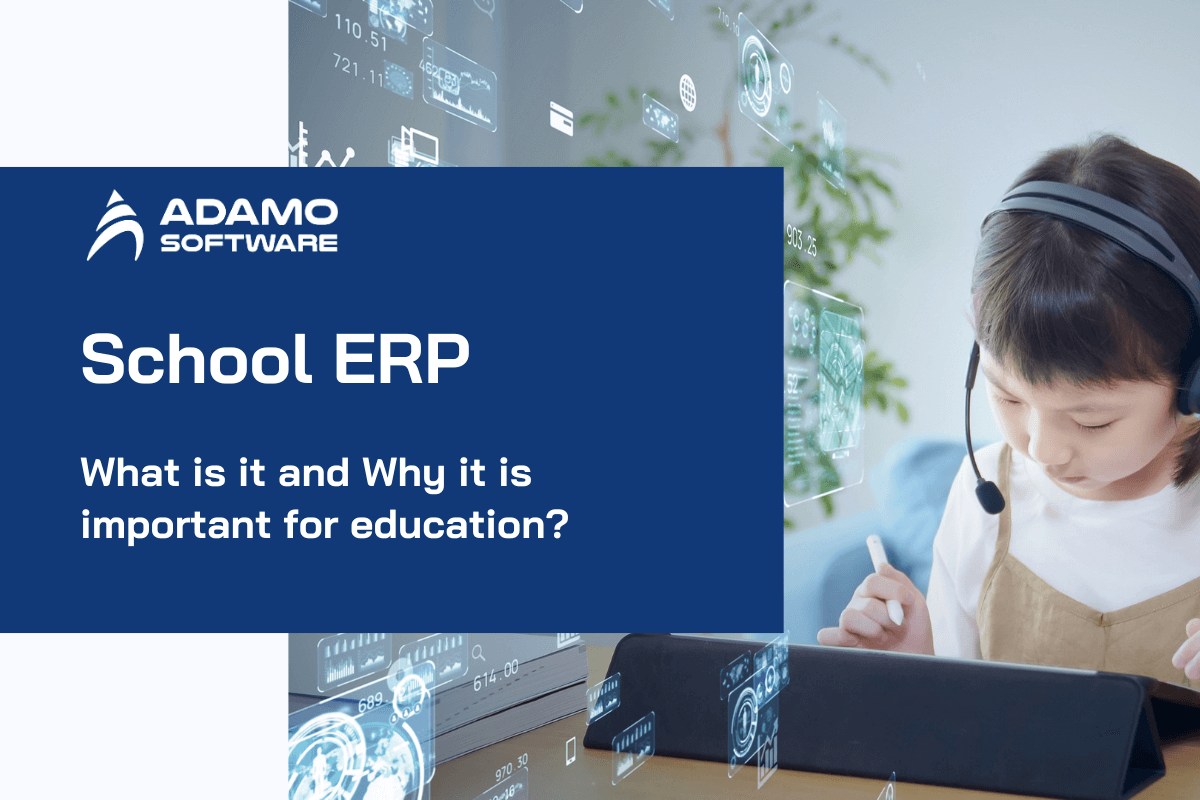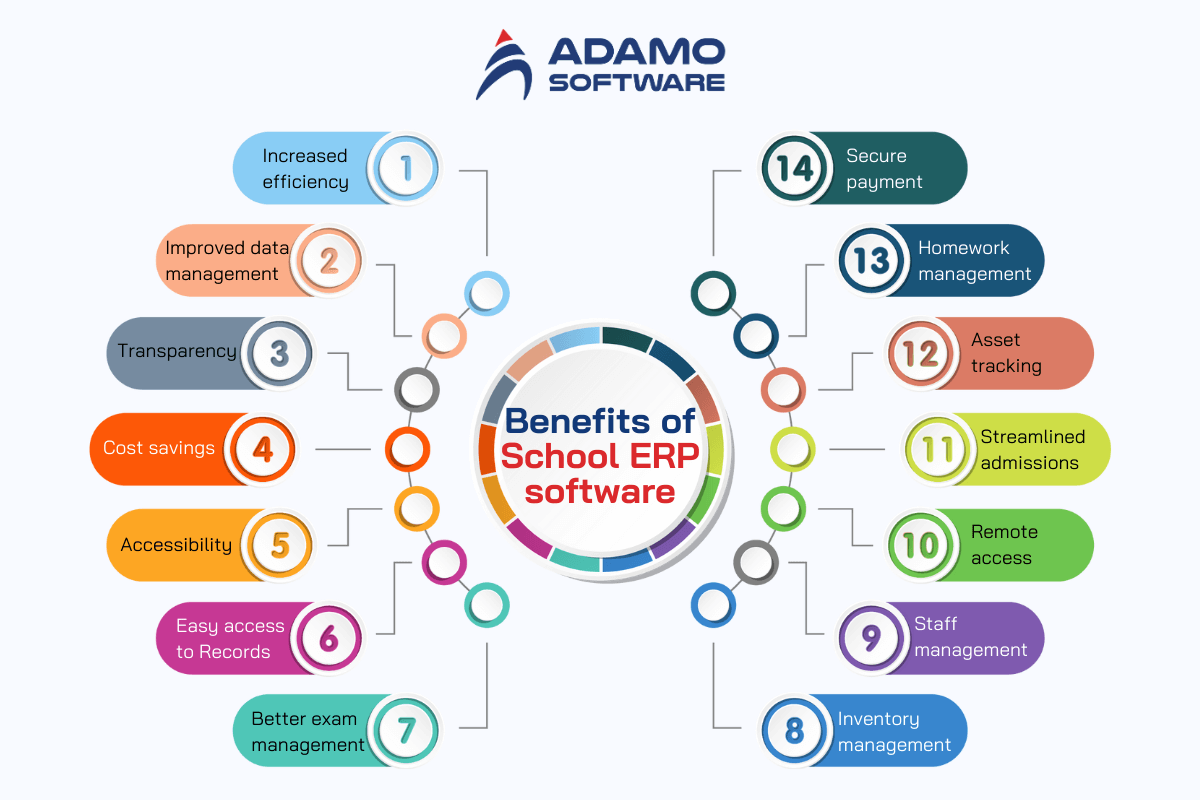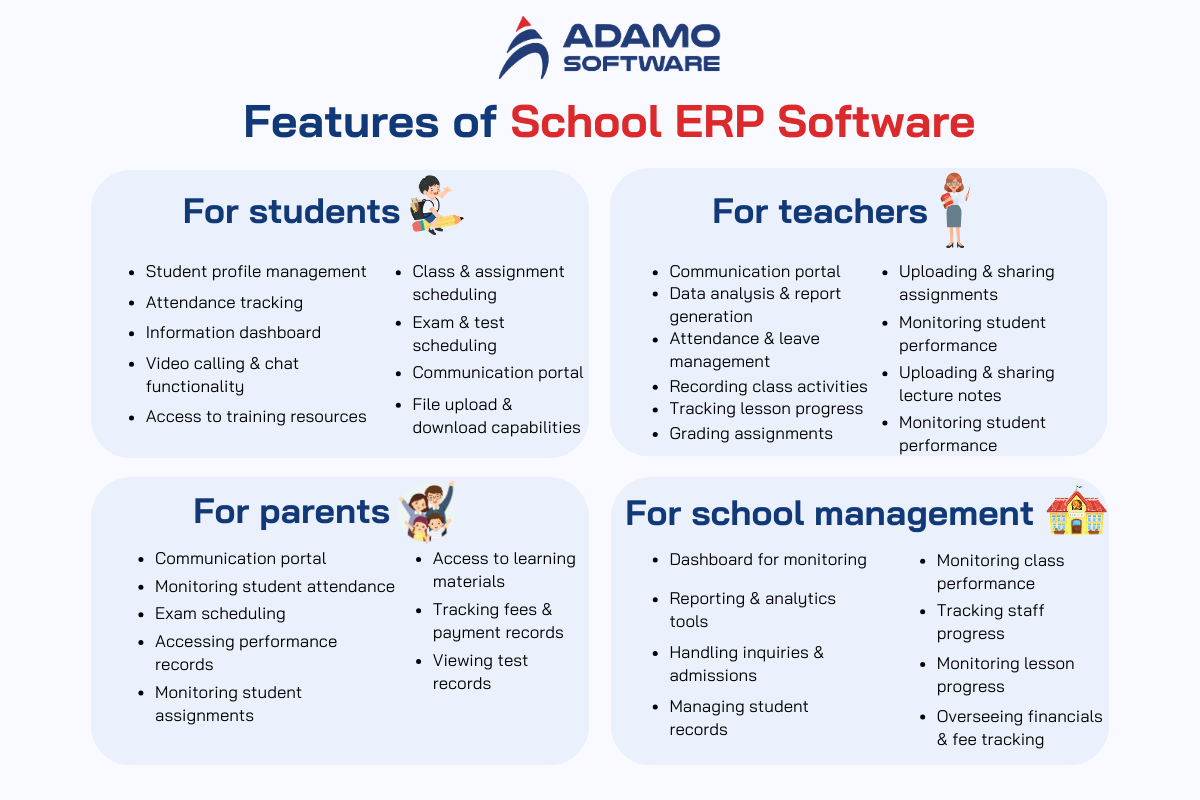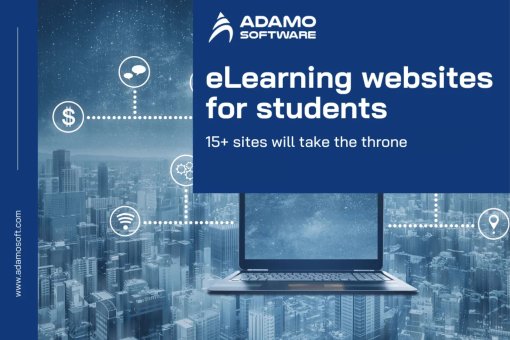What is a School ERP and Why It is Important for Education

Data management is not an easy task. As you know, schools collect and report a lot of information regularly. Everything from hiring and retirement data to funding sources, to whether money is being allocated and spent properly, is tracked. Manually tracking, processing, managing, and validating large amounts of rapidly changing information is difficult. Educational institutions constantly seek ways to improve efficiency and reduce administrative procedures. So, is there a better way?
This is where School ERP (School Prise Resource Planning) comes into play. It is called online school management software. School ERP is a comprehensive software solution designed to manage various administrative and academic functions in schools.
In this article, we will learn the details of School ERP software and its key benefits.
I. What is a School ERP?
School ERP (School-enterprise Resource Planning) software helps organizations optimize the management of their business operations. Each vendor has its unique characteristics, but in general, School ERP systems help automate functions that were previously considered “back-office.” The goal is to save time and thus reduce costs.
Functions typically include finance, procurement, human resources, and more. For organizations outside the K-12 space, School ERP software may also include modules for marketing, product management, or development. Removing these core functions from a system designed specifically for corporate processes can be complex. It often results in expensive customizations to remove features that are not relevant to education. This differs from School ERP software designed for K-12 school processes.
School ERP software allows you to manage your human resources, finances, and payroll online in a single system. Instead of using multiple separate systems, you can easily control your resources. Additionally, you can find ways to cut unnecessary costs. There is no need to search for paper records from different departments or worry about how to integrate operations.
More and more educational institutions are using School ERP systems to support district-wide process management. Tracking and managing operations electronically help:
- Save time in handling financial and human resources-related tasks
- Identify where funding is needed most and where costs can be cut
- Plan strategically for the next school year and allocate resources more effectively
II. School ERP vs. Business School ERP: What’s the Key Difference?
School ERP software is just starting to appear in the corporate world, but the value it brings is huge. Every organization needs to track its finances and manage its human resources. But when it comes to educational institutions and for-profit businesses, that’s where the similarities end.
There are many differences between educational software and School ERP software. To fully realize the benefits of a school ERP system, you need to find a system that fits your needs and the unique needs of education.
Let’s explore the key differences between the School ERP and Business School ERP
| School ERP | Business School ERP
|
| Break down silos and provide a single source of information about what is happening in the district. Integrate core district processes into a single system, more closely align the central office with each campus, and provide a higher level of support. | Integrate a business’s core processes into one system to ensure consistency, from product development and supply chain management to revenue generation from sales or marketing activities. |
| Include more advanced Human Resources functionality to manage benefits, payroll, and employee records to meet the unique needs of K-12.
Be better equipped to manage education-specific requirements, such as tracking teacher certification, managing employees with benefits or multiple positions (e.g., teachers who are also coaches), and pensions or state retirement plans.
|
Often includes a separate module for basic HR management, such as employee records, compensation, and benefits. This is typically a simple add-on to the main system, which is primarily focused on financials.
|
| Ensure compliance with labor laws, state and federal reporting, school finance requirements, regulations, etc. | Primarily aimed at ensuring regulatory compliance and meeting general corporate obligations. |
| Built with the understanding that every expense in K-12 comes with a catch-22. Designed to accommodate more complex charts of accounts to accurately track assets, liabilities, equity, revenues and expenses. | Designed for straightforward corporate accounting.
|
|
Developed to integrate with student information systems for real-time data and reporting. |
It may provide regular file transfer services that send static data between the School ERP system, and the Student Information System (SIS) according to a fixed schedule. This service may incur additional costs. |
III. Benefits of School ERP Software for Educational Institutions
Implementing a School ERP system provides numerous advantages for educational institutions. It helps streamline operations, enhance communication, and improve efficiency in managing both academic and administrative tasks.
Below are some key benefits of integrating a School ERP system into your school:

1. Increased Efficiency
One of the biggest advantages of implementing a School ERP system in schools is the boost in efficiency. By automating routine tasks and streamlining various processes, faculty, and staff can save valuable time and resources. These automated systems handle everything from attendance tracking to grading assignments, which allows teachers to focus on more critical tasks, like engaging with students.
Administrative staff can also benefit from automation. It reduces the workload associated with manual data entry and reporting, making day-to-day operations more efficient and error-free.
2. Improved School Data Management
Centralized data storage is another significant benefit of using School ERP systems in schools. When all information is stored in one place, it ensures accuracy and consistency across the board. Administrators, teachers, and students can access the information they need quickly and easily, without having to dig through multiple sources. Whether it’s student profiles, grades, or attendance records, having a centralized system ensures that data is always up-to-date and accessible from anywhere, at any time.
3. Transparency
School ERP systems promote transparency and accountability within the school community. With improved access to data, students, teachers, parents, and administrators can stay informed about important matters. This transparency fosters trust within the school community, as all stakeholders can see what’s happening and track progress. For example, parents can view their child’s performance, attendance, and upcoming assignments, ensuring that they are always in the loop.
4. Cost Savings and Paper Reduction
One of the often-overlooked benefits of a school management system is the reduction of costs and paperwork. By moving processes online, schools can significantly cut down on paper consumption, promoting a more eco-friendly environment. Digital forms, records, and communications eliminate the need for physical paper, which not only saves money but also contributes to sustainability efforts.
Additionally, reducing the reliance on physical documents makes record-keeping more efficient and secure.
5. Accessibility and Convenience
School management systems often come with mobile applications, allowing authorized users to access information anytime and from anywhere. This accessibility provides unparalleled convenience for all stakeholders. Teachers can update records on the go, parents can check their child’s progress, and students can access learning materials no matter where they are. The convenience of having all the necessary information at one’s fingertips is a game-changer for modern education.
6. Easy Access to Records
Keeping track of various records, such as student profiles, grades, and attendance, is crucial for the smooth operation of a school. School management software allows administrators to create and maintain different profiles and access them whenever needed. This system makes record management not only easy but also highly organized. No more sifting through piles of paperwork; everything is available digitally, ensuring quick access and easy updates.
7. Better Exam Management
With a school management system, exam administration becomes a breeze. Students can take tests and submit them online, and once the assessments are complete, it’s easy for schools to publish results. These systems also make it possible to manage exams for different classes and students with just a few clicks.
Additionally, School ERP solutions allow for the integration of external exams. Enables schools to upload results or connect with parents and students for further discussions seamlessly.
8. Secure Online Tuition Payment
Standing in long queues to pay tuition fees can be a hassle for parents. School management systems offer a secure platform for online payments, allowing parents to pay fees conveniently from anywhere. This not only simplifies the payment process but also ensures that transactions are secure and recorded in real time. School administrators can easily track payments without worrying about handling cash or other security concerns.
9. Homework Management
Managing homework becomes effortless with a school management system. Students can upload their assignments to the platform, and teachers can download, review, and grade them, all within the same system. This streamlined process eliminates the need for physical hand-ins, reduces the chance of lost assignments, and keeps everything organized. Teachers can also provide feedback directly through the platform, ensuring that students receive timely and constructive responses.
10. Seamless Communication
Effective communication is essential in any educational institution. With a school management system, parents, teachers, students, and administrators can easily connect to ask questions or share information. The platform allows for streamlined communication that can be checked with just a few clicks.
Additionally, with the integration of IoT devices, schools can create a connected network of devices on campus, further enhancing communication and operational efficiency. This connectivity brings all stakeholders closer and improves overall school management.
11. Asset Tracking and Management
Managing school assets can be a daunting task, but with a School ERP system, administrators can track all assets from a single screen. Whether it’s classroom supplies, sports equipment, or technology, having a centralized system for asset management reduces the reliance on multiple sources of information. This not only simplifies asset tracking but also helps prevent loss or mismanagement of resources.
12. Streamlined Admissions
School admissions can be a time-consuming process, but a school management system makes it seamless. Parents and students can fill out registration forms online, speeding up the process and reducing paperwork. All records are stored digitally, making them easy to maintain and access. The online admission process also improves organization, making it easier for schools to track applicants and ensure that nothing gets lost in the shuffle.
13. Remote Access for Parents
One of the key features of an online school management system is that it allows parents to stay connected with their child’s progress from anywhere. With remote access, parents can monitor their child’s attendance, performance, and assignment status. This level of involvement helps parents stay informed and engaged in their child’s education, creating a stronger partnership between the school and the home.
14. Effective Staff Management
Managing staff effectively is crucial for the smooth running of any school. A school management system can automate attendance tracking, salary generation, and staff availability management, helping school administrators make informed personnel decisions. By streamlining staff management processes, schools can ensure that their faculty and staff are supported and that their needs are met promptly.
15. Inventory Management
Keeping track of school supplies, uniforms, books, and other inventory items can be challenging. A school management system allows schools to maintain records of inventory items and check their availability at any time. The system can even automate purchase orders when supplies are running low, ensuring that the school is always stocked with the necessary materials.
Also read: 15 Best ERP for Schools to Consider in 2024
IV. How Does a School ERP Work?
A School ERP system operates on a centralized database, accessible to authorized users through a user-friendly interface. Different modules within the system serve specific functions, ensuring seamless data flow and information exchange between departments. Here is a breakdown of some of the important features of a School ERP system:
1. Student Information Management
This module handles all student-related data, including admissions, registrations, demographic information, academic records, attendance, and disciplinary actions. A School ERP system helps streamline the admissions process, reduces paperwork, and provides a centralized view of each student’s progress.
2. Academic Management
This module supports curriculum management, lesson planning, assignment creation and distribution, grading, and report generation. Teachers can use this platform to effectively plan courses for students, track student performance, and provide timely feedback.
3. Teacher Management
The system supports the management of faculty data, payroll, leave, professional development programs, and performance evaluations. It simplifies administrative tasks for human resource departments, streamlining processes like tracking teacher attendance, managing certifications, and handling contract renewals.
This ensures a smoother workflow while helping schools retain top talent by keeping staff records organized and up-to-date.
4. Financial Management
This module automates fee collection, expense tracking, invoice generation, and budget management. It provides real-time financial insights, helping schools make informed financial decisions. By centralizing financial data, schools can also ensure greater transparency and accuracy in their financial reporting and auditing processes.
5. Communication
The School ERP system streamlines communication among teachers, students, parents, and administrators. Features like email, messaging platforms, and discussion forums promote transparency while also fostering collaboration within the school community.
6. Library Management
This module helps manage the library’s information and knowledge resources, including books, journals, and digital content. Therefore, students and teachers can search for the required information from available data resources, track book borrowing history, and reserve materials online.
7. Human Resources and Payroll
The system streamlines human resources processes such as staff recruitment, hiring, leave management, and payroll management. The system saves paper costs, time, and manual steps, ensuring timely and accurate payments to staff members.
8. Data Analysis and Reporting
The School ERP system offers robust tools for generating reports on key areas like student performance, attendance patterns, and financial data. These insights enable schools to spot areas needing improvement and make well-informed, data-driven decisions for better overall management.
V. Common Features of School ERP Software

In this section of our comprehensive guide on developing a web-based management system, we’ll delve into the essential features you need to consider.
1. For Students
Student profile management
Attendance tracking
Information Dashboard
Video calling and chat functionality
Access to training resources
Class and assignment scheduling
Exam and test scheduling
Communication portal
File upload and download capabilities
2. For Teachers
Communication portal
Data analysis and report generation
Attendance and leave management
Recording class activities
Tracking lesson progress
Grading assignments, tests, and exams
Uploading and sharing assignments
Monitoring student performance
Uploading and sharing lecture notes
Facilitating remote teaching
Managing student records
Scheduling classes and exams
Video calls and chats with students
3. For Parents
Communication portal
Monitoring student attendance
Exam scheduling
Accessing performance records
Monitoring student assignments
Viewing test records
Access to learning materials
Tracking fees and payment records
4. For School Management
Dashboard for monitoring
Reporting and analytics tools
Handling inquiries and admissions
Managing student records
Monitoring class performance
Tracking staff progress
Monitoring lesson progress
Overseeing financials and fee tracking
VI. Adamo’s Custom School ERP – Unlocking Operational Excellence
Adamo Software leads in developing customized School ERP applications tailored to educational institutions’ specific needs. By offering bespoke solutions, Adamo ensures that schools receive a system that aligns perfectly with their unique operational requirements – Unlocking operational excellence.

Our custom School ERP platforms integrate various school functions. Including student management, communication portals, and financial systems, into one cohesive solution. This flexibility allows schools to enhance efficiency and improve communication. Enables to deliver seamless user experience for administrators, teachers, parents, and students.











